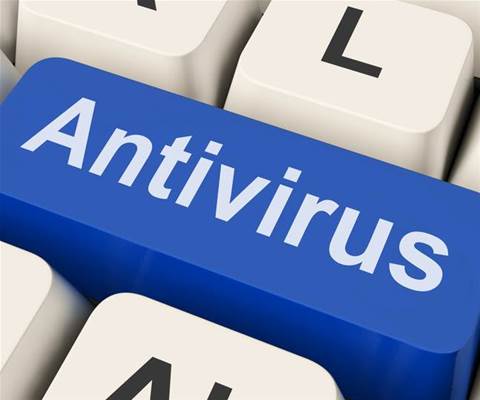We reveal the best free antivirus programs for Windows users.
Protecting your systems and data isn’t easy, but there’s no excuse for having no security – particularly as the likes of AVG and Avast have kicked off a whole industry of free antivirus software that can offer high levels of protection.
As you’d expect, these free programs don’t match the quality and range of tools offered by paid security solutions. But for those on a tight budget – or as an interim measure – free versions can be surprisingly good. And there’s a wide variety available to suit a range of tastes.
Beyond Windows Defender
For anyone running Windows 7, 8 or 10, the default option will be Microsoft’s own antivirus software. For Windows 7 users, that means Security Essentials; if you're on Windows 8 or later, it’s called Windows Defender, but despite the different names, they’re effectively the same thing.
And you’d be forgiven for thinking that this is all you need. After all, Windows Security Essentials/Defender is just about the easiest antivirus application to use and get to grips with, and it’s mostly invisible in the way it operates.
If you want the best protection, however, you’ll have to look further afield. For although it’s lightweight and irritation free, Windows’ built-in security hasn’t historically been the most efficient package when it comes to the job of protecting your PC from infection.
Over the past two years, it has consistently allowed more malware to slip through its net than its rival major free antivirus packages. And despite a slight bump in performance in recent times, it still lags a long way behind the competition.
There are other things to consider, though, as well as straight protection. Invariably, third-party free antivirus tools also deliver more features than Microsoft’s offering. Things like browser clean-up tools, software updaters and even rescue disk creation tools for when things get really bad.
In other words, although you can settle for the standard antivirus protection offered along with Windows, you’ll be better off in the long run with something extra. The question is, which package should you choose? Read on to find out which is best.
The free alternatives
Possibly the best-known alternative is AVG AntiVirus Free. It has been providing free virus protection since the 1990s, so there’s plenty of pedigree here. The modern AVG client actively detects and blocks viruses across your system, and also integrates with your browser to warn you away from known dangerous websites.
Recently, we've seen AVG's overall protection results improve markedly, and it’s now as good as any on the market. Alongside Avira Free Antivirus and Qihoo 360 Antivirus – a relative newcomer – it scored a perfect 6/6 for both protection and usability in AV-TEST’s latest results.
Our previous favourite, Avast, slips behind in this test due to slightly poorer protection results, but the difference between this and the very best is still small, so if you prefer Avast’s interface, it’s might well be worth sticking with what you know.
Panda, meanwhile, scored well for usability (false positives and so on) but fell short when it came to the impact the software had on system performance. Newcomer Qihoo performed well also, but when you download its software you need to remember to enable both its detection engines.
Whichever you choose, be sure to check the licence – you may have to purchase a paid version for continued business use.
Protection tests
Evaluating the effectiveness of antivirus software is a job for security testing specialists, which is why we’ve used results from a long-time global leader in this field, AV-TEST.
The tests are conducted is assessed by installing each antivirus program on a non-infected machine and looking at how they respond to malware threats. This is done by simulating a number of different attack scenarios, including e-mail attachments, infected websites and malicious files that have been transferred from external storage devices.
Using analysis software, the actions the software takes are monitored and assessed to work out whether the attack was completely blocked, partially blocked or not at all. These tests are carried out against two sets of threats: a selection of current malware, and a selection of widespread and prevalent malware discovered over the four weeks prior to testing.
AV-TEST protection test results (out of 6)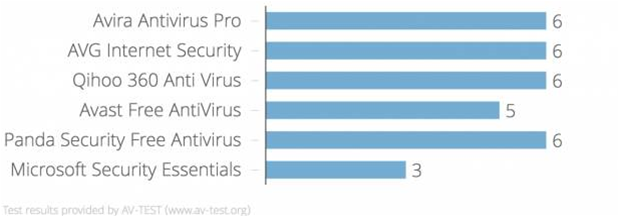
The overall protection score you see in the graphs is an amalgamation of the scores derived from the above two tests.
Performance tests
In testing typical actions are used to measure the influence on the system speed. These include downloading files from the internet, copying files locally and in a network, installing applications and running and using programs such as Word or Excel.
AV-TEST performance test results (out of 6)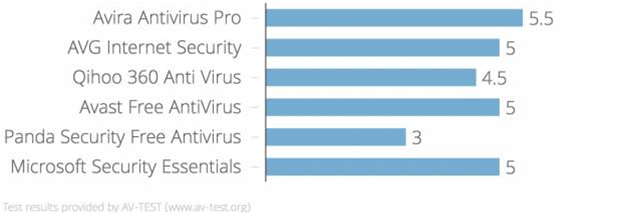
Note that performance results for Avira, AVG and Qihoo don’t necessarily apply to the free versions reviewed, as their paid versions offer differing feature sets.
Usability tests
Everyone knows we should install malware protection, but one of the main reasons people avoid it is that the software can intrude annoyingly on the everyday running of your PC or laptop.
AV-TEST usability test results (out of 6)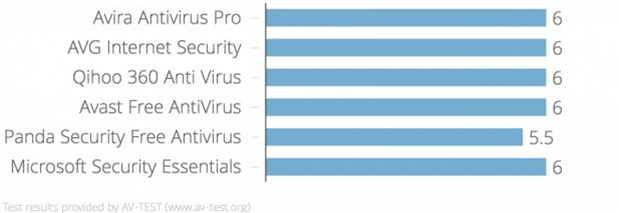
This is what the usability score reflects, and it takes into account everything from warning messages, general messages and blockages to false positives generated during system scans.
Interface design, features and irritations
We also consider other factors that aren’t measurable in our overall score for each program, including the design and layout, the presence and usefulness of any extra features, and how much free packages nag you to upgrade. All these factors go together to produce our overall score.
Avast Free AntiVirus
Overall score: 4/6
The most recent tests have seen Avast lose the lead over its rivals it used to hold, but Avast remains an easy-to-use tool that delivers effective virus protection. It’s basic in terms of what it does – as with all free antivirus packages – but it does include a handful of useful extra tools, which may well come in handy.
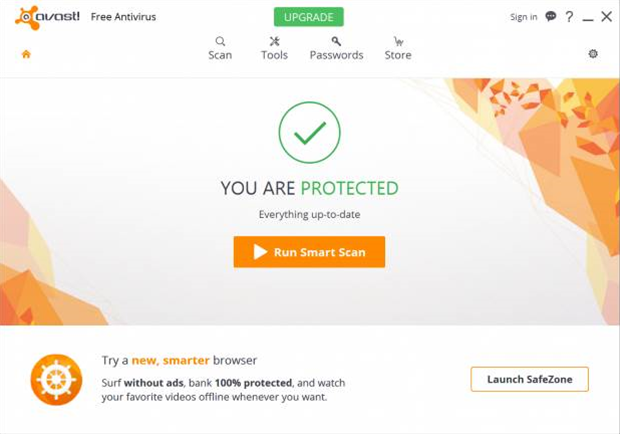
You get a secure password manager tool, a browser extension removal facility (useful for when you’ve got one of those annoying third party search tools cluttering up your toolbar), and there’s a software update tool as well.
We don’t like the interface much, however. It doesn’t make it clear enough which features are already installed and which need paying for, so you’re constantly clicking options, only to find they’re only they're free trials or need extra modules to be downloaded.
However, its protection levels remain very good for a free antivirus program, actively scanning files, email and your web activity for dodgy software, so it’s hard to complain too much.
Avira Free Antivirus
Overall score: 5/6
The results AV-TEST recorded are for the Avira Pro product, but since the free version of the software uses the same anti-malware engine, it should be just as effective at catching nasties on your laptop or PC. And in testing, both protection and usability ratings for Avira’s antivirus engine proved itself as good as any at intercepting nasties.
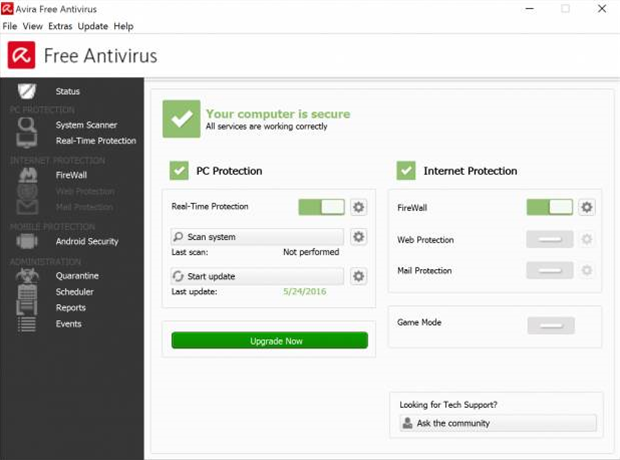
It scored a six out of six in the AV-TEST results, protecting against 99% of current threats (so-called zero-day attacks), and 99.9% of widespread and prevalent malware from the four weeks leading up to testing.
That’s impressive on its own, but Avira adds to this with an impressive balance of features, configurability and a refreshingly nag-free attitude. Best of all it’s always clear which tools are enabled in the free version and which are not.
You don’t get in-browser and email scanning like you do with Avast or other funky extra features, but protection levels and usability are just as high, and we prefer Avira’s more honest approach to encouraging you to upgrade to the paid version.
AVG AntiVirus FREE
Overall score: 4/6
AVG has a long and distinguished history in the antivirus industry, and was the original free antivirus company back in the 1990s. After a long time in the doldrums, AVG is now back with a bang, with protection and usability scores as good as any in the industry.
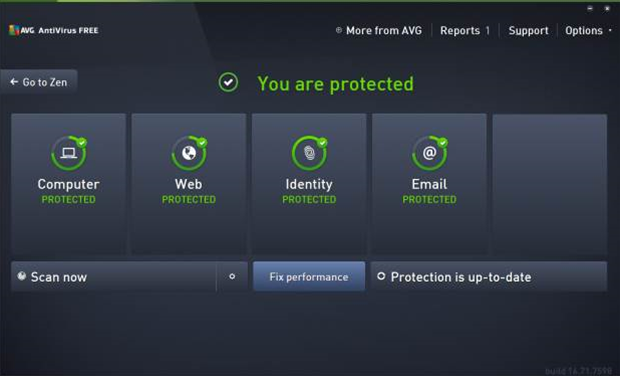
However, pure protection, important though it is, is not the be-all and end-all when it comes to free antivirus, and AVG does need to do some work – it isn’t the friendliest of the packages I've come across.
On installation, AVG attempts to sneakily switch you to the Pro version at the last-minute – something we fell for the first time around – and even once you’ve negotiated that hurdle successfully, you’ll be faced with a UI that’s littered with ads imploring you to upgrade and add premium features.
Moreover, AVG’s “extra” features aren’t the most useful, including Web TuneUp, a browser security measure, which irritatingly sets the firm’s own Secure Search as your default search engine. It does have the good grace to give you the option of reverting once you uninstall it, however.
Although anti-malware performance is good, then, AVG misses out on an overall award in this roundup. It’s a little too intrusive for our taste.
Microsoft Security Essentials/Windows Defender
Overall score: 3/6
Security Essentials has come on in a lot in recent times, but it still isn’t as good as the third-party antivirus applications for protecting you against infection and data loss.
In the last set of tests, it prevented only 86.4% of zero-day malware threats from gaining a foothold on our test PC, a good 13% behind the best of the third party free AV tools. The performance was much better with established malware, hitting a rate of 99.7% in this test in January and 99.6% in February.
Still, if you can put up with second rate protection, Microsoft’s product does have its benefits. You don’t have to put up with irritating adverts or attempts to upsell you at every opportunity, and it's largely well-behaved when it comes to false positives.
Panda Free Antivirus
Overall score: 4/6
If you can negotiate the firestorm of upgrade offers and tactics intended to get you to install the paid-for version of the software, you’ll find Panda’s free AV offering a decent alternative to the big name free AV packages.
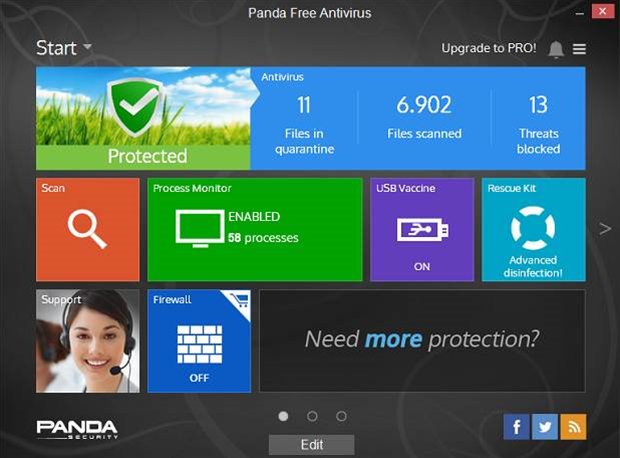
Its protection level is up there with AVG and Avira, with near-perfect scores across the board, and on the usability front it’s pretty good too, although it did detect a small handful of legitimate software packages as malware during our test scans.
Where it falls down is the impact it has on your laptop or PC’s performance and interface design. In particular, Panda slowed application installation significantly. And although the user interface is straightforward enough to understand and (in general use) it doesn’t batter you with adverts at every possible opportunity, it can’t be recommended for those with very high resolution screens since it doesn’t scale up correctly. Its window looks tiny on those types of display on Windows 10 and its window can't be resized.
Extra features are thin on the ground, but those you do get are handy. There's a process monitor, which shows you which processes are running, how many are accessing the internet, which it thinks are a threat and how many have been blocked. You can also set up scheduled scans, automatically “vaccinate” any USB devices plugged into your machine, run an extended cloud-based AV scan and create a rescue disk in case of real emergencies.
Panda’s overall performance and interface issue mean that Panda isn’t our favourite free AV package, but it doesn’t nag you too much to upgrade and if your laptop screen isn’t high-resolution, its excellent protection levels make it well worth considering.
Qihoo 360 Total Security Essential
Overall score: 5/6
Employing twin antivirus engines (from BitDefender and Avira) and a friendly, intuitive interface, Qihoo’s security software is a comparative newcomer to the security software game. AV-TEST looked at 360 Anti Virus, but it’s the same detection engines as Qihoo 360 Total Security Essential, so protection levels should be the same. When tested, Qihoo 360 Anti Virus gained near perfect scores.
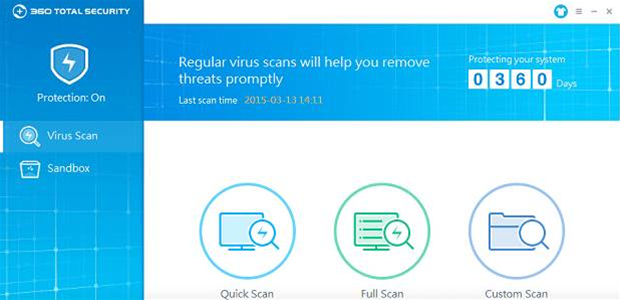
You’ll need to enable both the BitDefender and Avira detection engines to get this level of protection, however, as the software comes initially with only the former switched on by default. It isn't abundantly obvious how to do this, or indeed that you need to do it either. The (small) switch is found at the bottom left corner of the main window.
Surprisingly, despite the dual detection engines, Qihoo’s offering rates highly on the scale for usability, only blocking one of our legitimate actions during testing. And as far as interface design and extra features go, it’s easy to live with.
We found the interface simple and straightforward to get around. It’s easy to understand what the software is doing at most points. It doesn’t nag you about upgrading too much, and its virtual sandbox is a useful feature if you’ve installed a piece of software you’re not sure of and want to run it in safe surroundings.
The package also offers USB drive protection, scanning hard disks and thumb drives when they’re connected, and plugins for Chrome, Firefox and Opera.
Overall, a decent showing from Qihoo and well worth a try.
